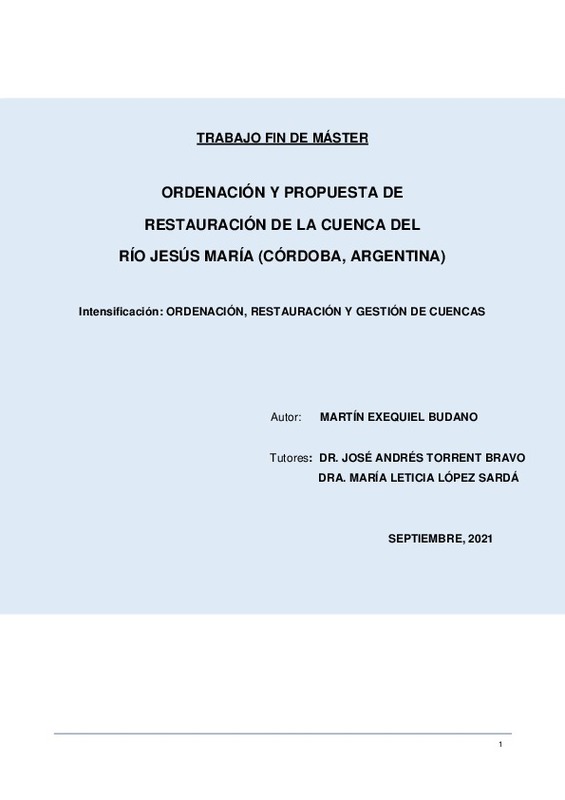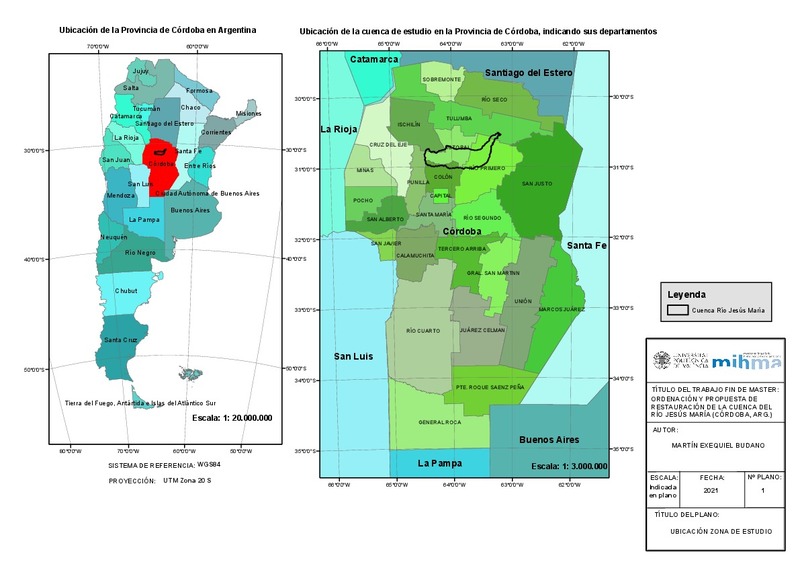|
Resumen:
|
[ES] La cuenca hidrográfica del río Guanusacate o río Jesús María ubicada al norte de la Provincia de Córdoba Argentina, por condicionamiento natural presenta una significativa tendencia a la generación de crecientes ...[+]
[ES] La cuenca hidrográfica del río Guanusacate o río Jesús María ubicada al norte de la Provincia de Córdoba Argentina, por condicionamiento natural presenta una significativa tendencia a la generación de crecientes repentinas debido básicamente a la morfología de su cuenca alta en donde predominan rocas cristalinas poco permeables, sobre las que evolucionaron suelos superficiales con una cubierta vegetal de baja protección hidrológica. Por otra parte, en la cuenca media y baja, la vegetación nativa ha sido reemplazada para su explotación agrícola lo que trae aparejado una disminución sustancial en la infiltración y aumento en la escorrentía, generando procesos de erosión hídrica acelerada en todas sus formas.
Los fenómenos torrenciales comienzan a originarse a partir de los caudales recogidos en la parte alta de la cuenca, y los daños aumentan con la cantidad de sedimentos transportados por la corriente hacia aguas abajo. Estos sedimentos proceden de la erosión, tanto de las laderas de los distintos cauces como de su propio lecho. La cuenca alta, con una superficie de 460,61 Km2, tiene una gran importancia ante estos fenómenos, de forma que cuanto menores sean los caudales y sedimentos aportados a los cauces de los barrancos, menor será el riesgo y severidad de las inundaciones.
Otro inconveniente de importancia son los reiterados incendios forestales que reducen la protección del suelo a la erosión y aumentan la cantidad de sedimentos arrastrados de la cuenca alta hacia la cuenca media y baja, donde la pendiente se reduce de manera considerable, obstruyendo la red de drenaje y provocando desbordes que afectan a una amplia región productiva.
Es por lo antes expuesto, que el objetivo de este estudio se centrará en buscar paliativos y soluciones a corto y largo plazo para subsanar los severos problemas de erosión hídrica e inundaciones que se vienen produciendo en los últimos años. Estas soluciones se llevarán a cabo mediante la restauración hidrológico-forestal de la cuenca alta del río Jesús María, a partir de un estudio integral que permitirá llevar a cabo la ordenación de la misma (actuaciones no estructurales) y medidas de tipo estructural (Biotecnias e hidrotecnias) con la finalidad de reducir la tasa de erosión hídrica, y al mismo tiempo el riesgo de inundación en la cuenca media y baja.
El objetivo ambicioso de este estudio, con escasos precedentes en la Provincia de Córdoba, es que no solo se implemente en esta cuenca, sino en todas aquellas que tengan problemas de esta índole. Estas estrategias traerían aparejados beneficios no solo sociales y económicos (por disminuir las pérdidas de vidas humanas y materiales) sino también beneficios ecológicos al permitir restaurar los bosques y su biodiversidad.
[-]
[EN] The watershed of the Guanusacate River or Jesús María River, located in the north of the Province of Córdoba (Argentina), naturally presents a significant tendency for sudden flooding due to the morphology of its upper ...[+]
[EN] The watershed of the Guanusacate River or Jesús María River, located in the north of the Province of Córdoba (Argentina), naturally presents a significant tendency for sudden flooding due to the morphology of its upper basin, where little permeable crystalline rocks predominate, on which soils with a vegetation cover of low hydrological protection evolved. On the other hand, in the middle and lower basins, native vegetation has been replaced for agricultural purposes, which produces a substantial decrease in infiltration and an increase in runoff, generating accelerated water erosion in all its forms.
Torrential phenomena begin to originate from the flows collected in the upper part of the basin, and the damage increases with the amount of sediment transported downstream. These sediments come from erosion, both from slopes and from their own bed. The upper basin, with an area of 460.61 km2 has a great importance in the face of these phenomena and that the lower the flows and sediments contribute to the ravines, the lower the risk and severity of flooding.
Another major drawback is the repeated forest fires which reduce soil protection against erosion and increase the amount of sediments carried over from the upper basin into the middle and lower basin, where the slope is considerably reduced, obstructing the drainage network and causing overflows affecting a large productive region.
It is for the above reasons that the objective of this study will focus on seeking palliatives and short- and long-term solutions to correct the severe problems of water erosion and floods that have been occurring in recent years. These solutions will be carried out through the hydrological-forest restoration of the upper basin of the River Jesús María, from a comprehensive study that will allow to carry out the management of structural and non-structural actions with the aim of reducing the rate of water erosion and at the same time the risk of flooding in the middle and lower basin.
The ambitious objective of this study, with few precedents in the Province of Córdoba, is that it is not only implemented in this basin, but in all those that have problems of this nature. These strategies would not only bring social and economic benefits (by saving lives and reducing damage) but also ecological benefits by enabling forests and their biodiversity to be restored.
[-]
|







